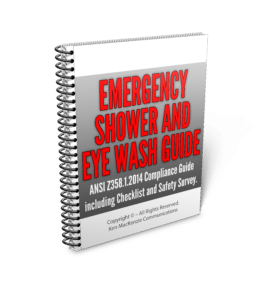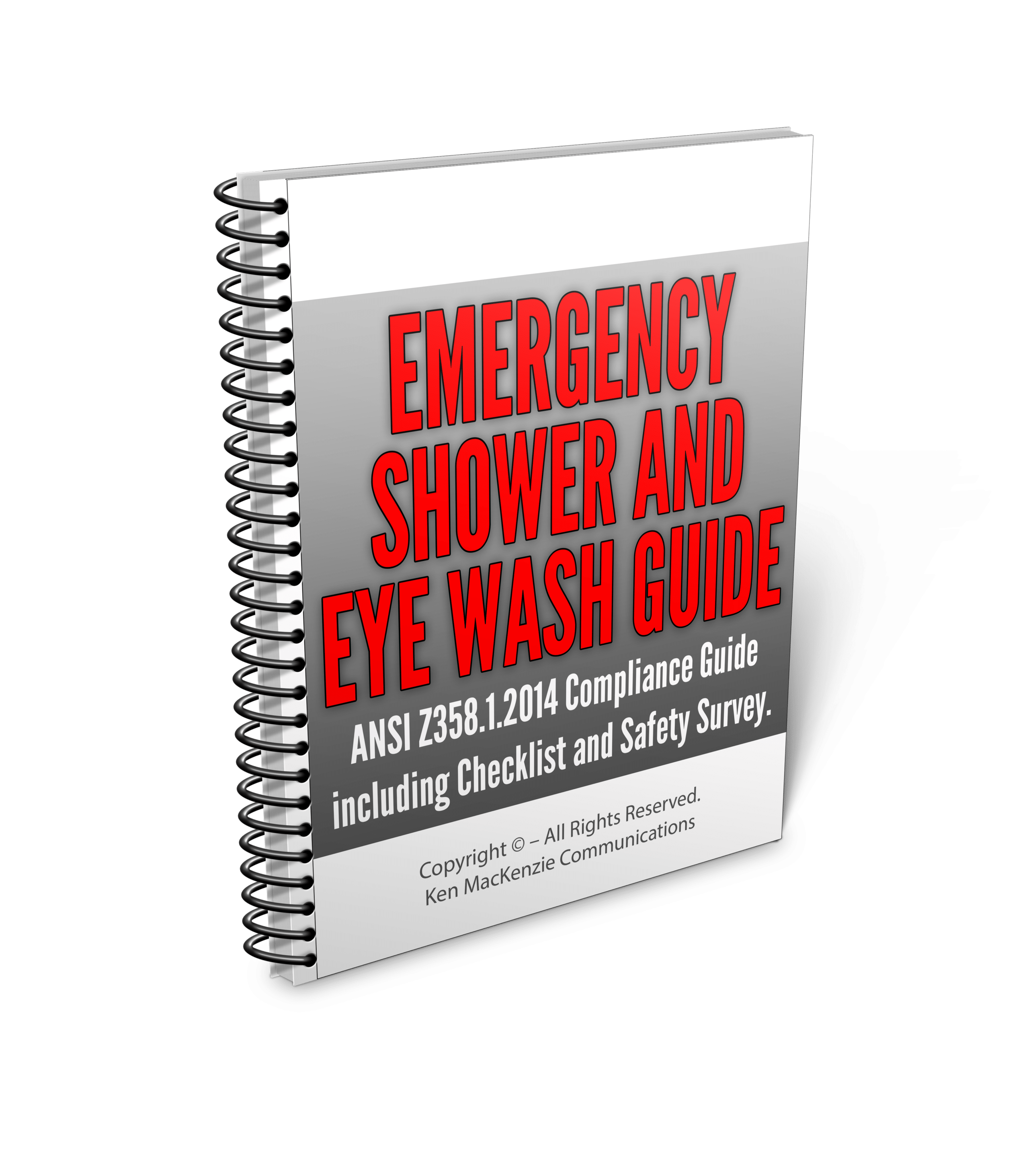
ANSI Z358.1 2014 standard for emergency shower and eyewash stations is Extremely Important
ANSI Z358-1 standard is a widely accepted guideline for the proper selection, installation and maintenance of emergency equipment.and, has gained significant importance within the safety industry.
It sets the guidelines for safety equipment fixtures and installation practices including plumbed and self contained emergency showers, plumbed and self-contained eyewash equipment, eye/face wash equipment, combination units and supplemental equipment.
ANSI Z358-1 2014 sets out how the equipment should perform, as well as testing procedures to ensure proper operation, installation, maintenance and training. Throughout the standard there are illustrations and appendices provided for further clarification.
ANSI Z358.1 2014 – OSHA Compliance and Legal Requirements:
To assure that workers are provided with “safe and healthful working conditions”; the Occupational Safety and Health Act of 1970 was enacted.
Under this law, the Occupational Safety and Heath Administration (OSHA) was created and authorized to adopt safety standards and regulations to fulfil the mandate of improving worker safety.
OSHA has adopted several regulations that refer to the use of eye wash and emergency shower equipment. The primary regulation is contained in 29 CFR 1910.151, which requires that “…where the eyes or body of any person may be exposed to injurious corrosive materials, suitable facilities for quick drenching or flushing of the eyes and body shall be provided within the work area for immediate emergency use.”
Employers should look for signs of hazardous materials. Look for areas where workers are using personal protective equipment such as goggles and liquid proof gloves and make sure the eye wash station and emergency safety shower drench are within the required distance as stated by ANSI Z358-1 2014.
ANSI Z358.1 – Non Compliance
OSHA may elect to impose penalties from warnings and fines to rare plant shutdowns if employers do not comply with the ANSI Z358.1 2014 standard.
It’s important to note that emergency eye wash and emergency safety shower units are designed to deliver water to rinse contaminants from a user’s eyes, face or body.
They are a form of first aid equipment to be used in the event of an accident, but they are NOT a substitute for primary protective devices such as eye and face protection and protective clothing.
Again, a safety shower is not an alternative to safe procedures for handling hazardous materials.
Safety Shower and Eye Wash Units Must Meets ANSI Z358.1 2014 Standards
It is imperative that eye wash and safety shower units meeting ANSI Z358-1-2014 be within 10 seconds travel time from a hazard.
However, there are other considerations and, in this regard, please see safety shower location Information.
This Standard also requires that safety shower valves be of a simple operation; that they turn off to on in one second or less, and provide hands free operation once activated. The Standard also requires that the flushing fluids be tepid.
On-the-spot decontamination
Emergency safety showers and eye wash stations provide on-the-spot decontamination and allow personnel to flush away hazardous substances that can cause injury.
Splashing accidents demand prompt and effective action. The affected body part should be flushed for a minimum of 15 minutes using a clean supply of flushing fluid under low pressure.

A great source of guidance regarding the installation and operation of emergency eyewash and shower equipment. ANSI Z358.1 PDF
Safety Shower and Eye Wash Guide
This Guide means to summarize the key points within the ANSI Z358-1 2014 standard, but not act as a substitute. It is recommended that the ANSI Z358.1 be consulted directly for further detail.
ANSI Z358-1 provides detailed information regarding the installation and operation of emergency eyewash and shower equipment. OSHA, therefore, has often referred employers to ANSI Z358-1 as a recognized source of guidance for protecting employees who are exposed to injurious corrosive materials.
OSHA, therefore, has often referred employers to ANSI Z358-1 as a recognized source of guidance for protecting employees who are exposed to injurious corrosive materials.
Frequently Asked Questions (FAQ)
What is ANSI Z358.1 ?
The ANSI Z358.1-2014 standard establishes a universal minimum performance and use requirements for all Eyewash and Drench Shower equipment used for the treatment of the eyes, face, and body of a person who has been exposed to hazardous materials and chemicals.
What is the OSHA standard for eyewash stations?
The OSHA standard 29 CFR 1910.151(c) requires eyewash and shower equipment for emergency use where the eyes or body of any employee may be exposed to injurious corrosive materials.
What is the latest version of ANSI Z358.1 ?
It was revised in 1990, 1998, 2004, 2009 and again in 2014. This Compliance Checklist summarizes and graphically presents the provisions of the 2014 version of the standard.
Brief overview on how to use equipment:
To use emergency eye wash:
If working in a lab that has multiple occupants, have someone call 911 while you are flushing eyes, if alone flush eyes first.
Immediately flush eyes for at least 15 minutes while flushing Keep the eyes open and rotate the eyeballs in all
directions to remove contamination from around the eyes. An injured person may need help holding the eyelids open.
Call 911 to seek medical attention after flushing is complete or go to your nearest medical treatment facility
Have someone bring or fax the Safety Data Sheet for the chemical to the doctor.
Report the injury or exposure to WVU EH&S.
To use emergency shower:
If working in a lab that has multiple occupants, have someone call 911 while you are showering, if alone shower first.
Immediately flush the affected area with copious quantities of water for at least 15 minutes. Protect the eyes from
inadvertent contamination.
Remove contaminated clothing, jewelry, and shoes. Don’t let modesty slow you down. Every second counts. Use a clean
lab coat if available to provide privacy and warmth.
Call 911
Call 911 to seek medical attention after showering is complete or go to your nearest medical treatment facility
Have someone bring or fax the Safety Data Sheet for the chemical to the doctor.
Report the injury or exposure to WVU EH&S.
Remember, emergency showers and eyewashes are not a substitute for safe work practices. When there’s
a possibility of a chemical splash, proper handling techniques must be used. Personal protective devices,
such as face shields and/or goggles, gloves and aprons must be worn.
Safety Shower Requirements | 5 Factors to Consider
Tagged with: ansi z358 safety equipment • ansi z358.1 2004 • ansi z358.1 2009 • osha
Filed under: UNITED STATES

